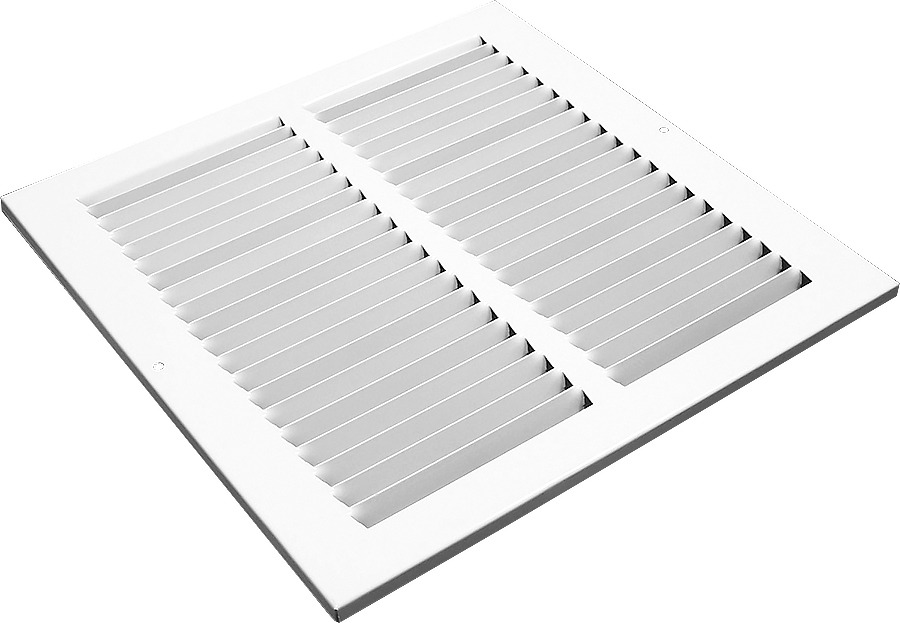
Contrary to popular belief, return placement just doesn’t have that much influence on air patterns in a room. There are a lot of people who either see red or think I’m crazy when I make this statement in classes. It goes against everything that most guys have been trained to believe, I should know I’m one of the guys who used to think returns had a huge impact on air movement.
It’s important to understand that the air patterns of return grilles rarely influence supply register air patterns regardless of the amount of air moving through the return grille. The illustration below shows their influence to be very limited to a close proximity from the face of the grille.
Even though returns don’t have much influence over air patterns it’s a good idea to place them in a location that won’t be directly influenced by supply discharge air allowing it to short circuit its mixing action with room air. Years ago we were called in to perform air diagnostic test on multiple gas fired units in a church that were located in an attic. The return grilles and supply diffusers were standard issue size of 2 X 2 for a drop down ceiling. One of the things we uncovered as we were testing these units in the heating cycle was that the return grille temperatures were quickly climbing to over 90˚ while the room temperatures were only 70˚ and very uncomfortable. After further testing we soon discovered that low airflow from the supply diffusers was not allowing the supply air to be discharged away from the ceiling far enough. The heated air which was already going to have a problem making it down off the ceiling was simply moving across the drop down ceiling tiles and recirculating directly into the return which was about 5 tiles over.
Return Grille Sizing
The majority of issues with duct systems typically fall on the return side of the duct system. Just as the typical return duct system is undersized so are the grilles that are attached to these ducts.
The speed of the air moving through of a return grille should typically be kept in the 300 FPM (Feet per Minute) to 500 FPM range to reduce noise through the grille. It’s easy to hear a grille that exceeds this velocity range as it is usually accompanied by an irritating level of noise. Many times this noise will be in the form of a whistle or low pitched hum that resonates whenever the fan in the HVAC system is operating. If you want to verify the speed of air moving through the return grille, you're going to need an anemometer.
For return filter grilles which have the filter located behind the grille face the maximum speed of the air moving through the grille should not exceed 400 FPM. When sizing a filter grille, look at the engineering data for the grille you are considering. Look for the 400 FPM column and find a CFM value that is equal or slightly higher than what you need. The filter grille size that matches up to that value is what you will need in size. An approximate rule of thumb to use when engineering data is not available is to multiply the filter grille area in square inches by 2 CFM for each square inch. This should keep the face velocity of the filter grille below 400 FPM. Using this rule of thumb method you would need a 20 X 20 return filter grille for a 2 ton unit rated to move 800 CFM. How often do you see a 20 X 20 return filter grille on a 2 ton unit? Answer: Not often enough.
Return Grilles with Transfer Ducts
With return grilles being used with transfer ducts in central return applications to relieve room pressures, it is important to use a grille with very low resistance to airflow. Most guys just slap on any grille that will fit the rough opening not considering that natural pressure differences have to allow air to make it back to the return once a door is closed. The use of stamped face grilles in this application might not produce the results that are hoped for. Instead the use of a commercial grade grille will yield better performance.
I know there are a lot of you guys who read this that have some undersized return grille horror stories. I want to hear them and see pictures if you have them!
_________________________________________________________________________
About the Author
David Richardson is a curriculum developer and instructor at the National Comfort Institiute (NCI).
This article is used with the author's permission.

